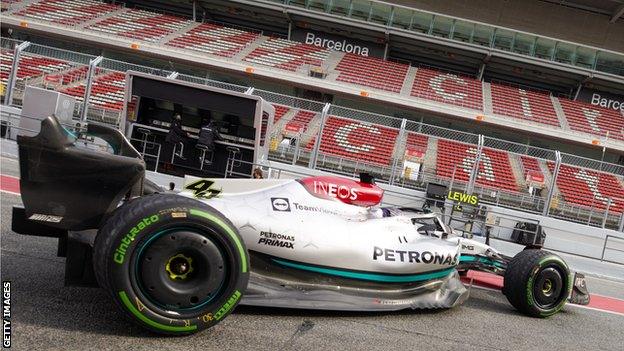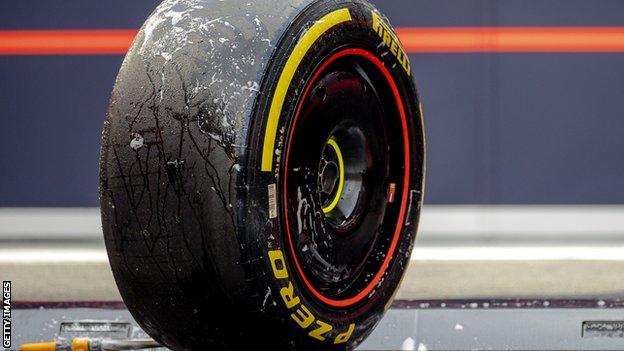Formula 1 pre-season testing: Why are the cars bouncing, and will racing be closer in 2022?
- Published
- comments

Lewis Hamilton set the fastest time during three days of pre-season testing at the Circuit de Barcelona-Catalunya
The first pre-season test of a new era of Formula 1 ended on Friday, and a glance at the timesheets might suggest very little has changed.
Lewis Hamilton led new team-mate George Russell in a Mercedes one-two, the two Red Bulls of Sergio Perez and new world champion Max Verstappen were third and fourth fastest, and the Ferrari drivers fifth and sixth.
So much for F1's much-vaunted rules revolution, introduced this season with the intention of creating closer, more competitive racing, you might think.
Well, perhaps.
The truth is that, yes, very few within F1 would be surprised if Mercedes and Red Bull were indeed the two fastest teams when the season starts in Bahrain next month.
But at the same time it would be unwise in the extreme to draw too many conclusions from three days of running in Barcelona this week.
For one thing, headline lap times in pre-season testing have always been notoriously unreliable as indicators of true competitiveness - there are too many variables any year, and that applies even more so now, after the biggest rule change for 40 years.
Russell said he believed the times were "absolutely unrepresentative" of the true competitive picture, and that Ferrari and McLaren were in the best shape.
McLaren driver Lando Norris, fastest on the first day, disagreed.
"Mercedes never look that good in testing," he said. "If they are good in testing, it probably means they are going to be incredible by the first race.
"We can see a picture. I think we are in a decent position. But Mercedes and Ferrari have looked very good since day one. They have been at the top of the timesheets and their long-run pace looks good.
"Ferrari look very, very strong, but Mercedes and Red Bull are right there with us, and personally I'd say a little bit ahead at the moment."
At the same time, there were very specific reasons why it is even more difficult to read into the times. Particularly because of an unexpected phenomenon from which all the teams were suffering to one degree or another - bouncing, or 'porpoising', on the straights.
Why are the cars bouncing?
This is quite a technical topic, but it's important to understand for a clearer picture of the week's test, so please bear with me.
The new rules have fundamentally changed the way the aerodynamics of F1 cars work.
In an attempt to make it easier for cars to follow each other, a greater proportion of the total downforce is now created underneath the floor.
This is done using something called 'ground effect'. The flat bottoms that have been on F1 cars since 1983 have been replaced by a shaped underbody, using two 'venturi tunnels' running the length of the floor on either side of the driver.
These are used to accelerate the air to create a low-pressure area under the car that sucks it towards the ground - downforce.
The problem is the downforce increases as the speed goes up. This pushes the car closer and closer to the ground. And when it gets down to a certain height, the airflow is disrupted - or 'stalls' - and the downforce suddenly decreases.
The car then lifts up, whereupon the airflow under the floor becomes smooth again, speeds up and starts to increase the downforce - until it stalls again, and so on.
The result is a high-frequency 'bouncing' down the straights at more than 180mph - and the return of a phenomenon last known in F1 between 1979 and 1982, which was the last time ground-effect aerodynamics were permitted, when it was known as 'porpoising'.
The teams have powerful computer simulations. But this aspect of aerodynamics is hard to simulate accurately and none of them picked up that this would be a problem. So all have been caught by surprise this week.
Alpha Tauri driver Pierre Gasly said: "I must say it is not that pleasant. Driving-wise it was a bit shocking the first time it happened when we tried the car because we didn't really expect it. But it is just finding ways to go around it."
As Ferrari team principal Mattia Binotto pointed out, fixing the bouncing is relatively easy - teams can just raise the ride height. But this affects performance. So all will now be working on ways of reducing the effect while keeping downforce levels as high as possible.
All the teams suffered from this, but some more than others - and Mercedes, in particular, felt they had been hit hard.
"There have been a lot of unexpected issues," Russell said, "which have been quite visible. Some teams have it quite well under control and some clearly do not."
In fact, when Russell had finished his media duties at lunchtime on Friday, he flew straight back to the Mercedes base in the UK to go on the simulator and work on developments.
"It was always the plan," he said. "It was either this evening or tomorrow, but it's going to be a long season ahead and rest on a Saturday [is important]. It's better to have a late one tonight.
"We have arrived with our best estimate of where to place the car but there are a lot things on track that are quite different to what was expected."
Russell said he expected to see "some changes" by the time of the final round of testing in Bahrain from 10-12 March.
"This season the development slope is going to be pretty rapid for everyone and whoever can get on top of it most quickly will be on top come the end of the season," he said.
Will the racing be closer?
Just as it is too early to judge the teams' individual performance levels, it is also difficult to judge whether the new rules will have their desired effect of closing up the field and making overtaking easier.
The list of best lap times for the week was relatively encouraging - there was just over a second between the fastest and seventh fastest teams, and McLaren and Ferrari looked close to the Mercedes and Red Bull.
And while Alpine, Alfa Romeo and Haas were some way off, all three had technical problems that made it an especially unrepresentative week for them.
Teams' best lap times from Barcelona testing | |
|---|---|
Team (driver) | Time |
1. Mercedes (Lewis Hamilton) | 1:19.138 *** |
2. McLaren (Lando Norris) | 1:19.568 ** |
3. Red Bull (Sergio Perez) | 1:19.556 ** |
4. Ferrari (Charles Leclerc) | 1:19.689 ** |
5. Aston Martin (Sebastian Vettel) | 1:19.824 *** |
6. Alpha Tauri (Pierre Gasly) | 1:19.918 ** |
7. Williams (Alex Albon) | 1:20.318 ** |
8. Alpine (Fernando Alonso) | 1:121.242 * |
9. Haas (Nikita Mazepin) | 1:21.512 * |
10. Alfa Romeo (Guanyu Zhou) | 1:21.885 * |
*** denotes C5 tyre; ** denotes C4 tyre; * denotes C3 tyre. C5 is softest; C1 hardest. | |
"The times are very close, which was one of the intentions of the new regulations," said Ferrari chief Binotto.
"And the cars are so different. There will be differences in lap time, but not as big as the differences in designs."
As for whether the racing will be closer, there were mixed signs.
A number of drivers said it appeared to be easier to follow closer behind another car. But that does not necessarily mean overtaking will be easier.
On the final day, Russell followed Norris closely to try to get a read on overtaking, and the news was not all good.
"We can follow closer but, from what we've seen, the slipstream effect is definitely less effective," Russell said.
"I got right up behind Lando and I was a car length or two behind him and I couldn't catch him down the straight, so that was slightly concerning. Let's see."
Norris said: "There is a positive and a negative from it. I don't know which one is the bigger effect at the minute."
There are also mixed signals regarding the tyres.
In theory, Pirelli has produced a more durable design that will allow drivers to push much closer to the limit in races, rather than having to lap seconds off the pace to keep temperatures under control and reach optimum stint lengths. This should also allow drivers to follow other cars closely without the tyres overheating and forcing them to back off.

Pirelli has supplied tyres in F1 since 2011
But Aston Martin driver Lance Stroll was withering about the new tyres on Friday.
"For me, the behaviour has been very similar to in the past," the Canadian said.
"From what I've felt on the long run, they overheat, they degrade, do the same things that the tyres have been doing in previous years."
Not everyone was so negative, though.
Alfa Romeo's Valtteri Bottas said the tyres "have been feeling a bit better than I was expecting".
And Ferrari's Carlos Sainz said: "I did quite a bit of testing last year and it looked like they are suiting well the new generation of cars. It looked like they at least allowed you to push bit more on them and a bit less overheating, a bit less degradation.
"It is still a tyre that degrades and overheats. But the scale - I feel like it's a bit better and the work done seems to start to pay off a bit."
On every level, then, there is not a clear picture as yet as to what F1 2022 will look like. The next test in a fortnight's time should clear some of the fog.

Gassed Up: Rapper Mist takes on celebrity opponents in a daring driving challenge
Villanelle and Eve are back: Watch the trailer for the extraordinary new series of Killing Eve

